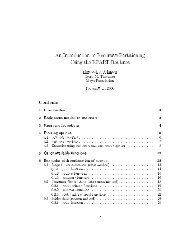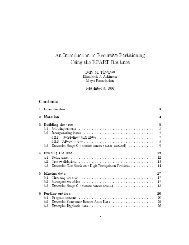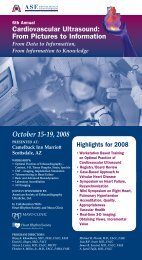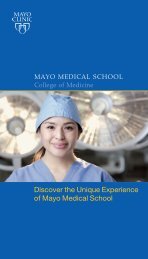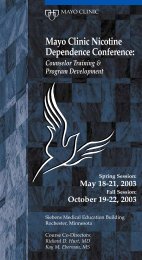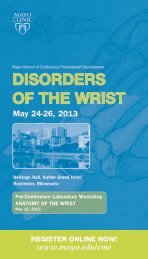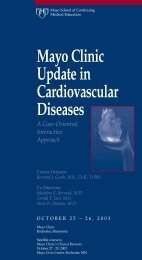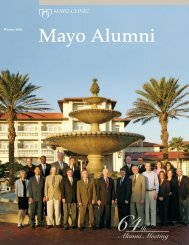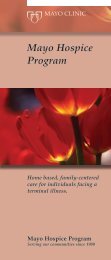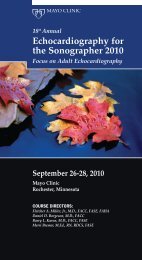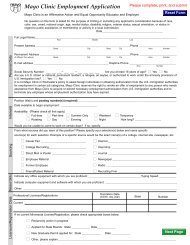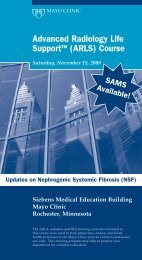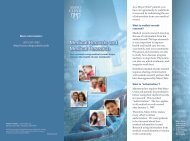current issue - Mayo Clinic
current issue - Mayo Clinic
current issue - Mayo Clinic
Create successful ePaper yourself
Turn your PDF publications into a flip-book with our unique Google optimized e-Paper software.
A novel model for resident training<br />
From the resident perspective<br />
begun to incorporate simulation<br />
training into our residency<br />
curriculum,” says Dr. Nitsche.<br />
He says converging factors have<br />
led to a need to change residency<br />
training, including the workhours<br />
limit and significant<br />
increases in technology and<br />
the amount of information<br />
physicians need to learn.<br />
“Sticking with the old ways of<br />
training young doctors when<br />
new methods exist is comparable<br />
to a carpenter not using power<br />
tools,” says Dr. Nitsche.<br />
Dr. Gostout says new ideas in<br />
medical training can take a<br />
decade to catch on. “Dr. Brost<br />
is far ahead of many educators<br />
in the design of this program,”<br />
she says. “He knows how to<br />
teach, create models from simple<br />
things and continue to create<br />
models for new problems we<br />
encounter. When I talk to<br />
colleagues around the country<br />
about PRIMER, they say they<br />
wish they had it. The program<br />
is a great boon to our maternal<br />
and fetal medicine program<br />
education and practice, and we’re<br />
fortunate to have Dr. Brost as<br />
its champion.”<br />
Daniel Breitkopf, M.D. (OBG ’10), residency director, Department of<br />
Obstetrics and Gynecology, says residents who complete the PRIMER<br />
program have more confidence on Day One. “They’re faster at doing<br />
simple tasks such as suturing and more accurate at tasks such as<br />
examining patients in labor,” he says. “Our patients benefit from residents’<br />
skills, and less double-checking is required of supervising physicians.<br />
Dr. Brost was a pioneer in advancing the skill level of incoming residents.<br />
Other institutions have replicated the concept, but none devote two<br />
weeks to it. The department should be credited with having the foresight<br />
to invest in this innovative program.”<br />
Elizabeth Cozine, M.D. (MMS ’11, FM ’14)<br />
Second-year resident, Family Medicine<br />
“It was great to have family medicine and OB/GYN<br />
residents working together from the start. Developing<br />
those relationships helps to build camaraderie and<br />
trust that’s useful in practice.<br />
“I’m grateful we have institutional and departmental<br />
support for the program. Allowing interns this<br />
dedicated time presents significant coverage <strong>issue</strong>s for the department,<br />
and the staff members pick up the slack. It’s a testament to our program<br />
directors and staff who believe this is useful training for residents.”<br />
Sara Oberhelman, M.D. (FM ’11)<br />
Consultant, Family Medicine<br />
“My first rotation was obstetrics, and I felt incredibly<br />
prepared to take on clinical duties. The teamwork<br />
instilled from the start among family medicine and<br />
OB residents changed the dynamics in labor and<br />
delivery, we were told, and helped the next<br />
generation of physicians work as true colleagues.<br />
“Dr. Brost encourages residents to come up with ideas to improve the<br />
program, including the models. I modified his circumcision model to teach<br />
pediatrics residents and medical students in the nursery. When I was<br />
starting my residency, I didn’t recognize how innovative the PRIMER approach<br />
is. It’s phenomenal and shows how much <strong>Mayo</strong> values education.”<br />
2013 | No. 1 11



